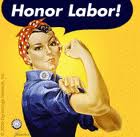When the inevitable battle with public-sector employees in Iowa begins to rage here in the next few months and every elected Democrat in the state marches in lock-step with union negotiators, the following will help you understand this phenomenon.
Not only does their ideology lend itself to supporting the concept of an organization/government “protecting” people from the free market–it turns out that this cast of Democrat legislators largely are the unions.
Iowa House Democratic Caucus by Occupation
Below is a look at the occupations of the 46 Democratic members of the Iowa House that will be in office the next two years.
Teachers/Principals former and current = 12
Attorneys = 7
Occupation Unclear = 4
Social Work = 2
1 Each of the Following— Realtor, Farmer, Pharmacist, Grants Coordinator, Funeral Home Business, Golf Course Owner, Banker, Accounting Clerk, Head of Non-Profit Organization, (12 more random single occupations not listed here).
Number who have direct/indirect past or current union backgrounds (mostly public-sector) = 21
Trends
By far the biggest takeaway here is that of the 42 who had a clear current or former occupation that could be found on their legislative page or campaign website, a whopping 21 of them had direct connections to unions–the vast majority of which were public-sector. That is a full 50% of the caucus and does not even include Bruce Hunter, a ranking member of the Labor Committee whose wife is the State Political Director of the AFL-CIO, or Anesa Kajtazovic who goes out of her way to mention in her bio that at a young age her father’s experiences in the workforce led her to be “reminded how important union representation can be.”
The second biggest trend is that 12 of the 42 members with clear employment histories are current or former teachers. This explains why year after year we have a fight in the legislature to increase spending on education by 4% for “allowable growth”–not to mention why firing a teacher is almost unheard of, why there is currently no substantive teacher evaluation, and why there needs to be a Republican push just to ensure that students aren’t passed out of the 3rd grade without being able to read at the proper level, a policy that would seem to be the epitome of common sense. What is not so easily explained is with such a large number of educators doubling as legislators and a majority of the state budget dedicated to it every year, how are the results embarrassingly insufficient in such a large number of districts.
Revealed above is the gross disproportion of representation that unions have in the General Assembly in comparison to the percentage of Iowa’s workforce that they account for. As of 2011 Iowa had nearly 1.4 million people in the workforce. Of this number only 155,000 were in unions (11.2%) and an additional 32,000 were effectively represented by union negotiations while not being listed members, thus bringing the total number of employees directly or indirectly represented by unions to 187,000, or 13.5% of the workforce. Of note here is that the 1.4 million Iowa workers number actually excludes those self-employed so the percentages represented by unions are actually slightly smaller than those listed above. Even taking the larger percentages, while only 13.5% of Iowans are either in or governed by unions, in the Iowa House’s Democratic caucus a full 50% have direct or past connections with unions.
Coming Up
Before the session gavels in I will also do a breakdown of the Republican Caucus by occupation in both Houses (unless one of the Liberal bloggers reading this wants to save me the leg work). It would be very interesting for comparison purposes and may further explain the massive partisan divide we see year after year–my guess is the top 3 for Republicans in some order are small business owners, lawyers, and farmers.
Later this week we will take a look at 3 specific cases that symbolize this dynamic of union/citizen representation in the House, and next week we will have a breakdown of the occupations of the Democrat Caucus in the Iowa Senate. This will be followed by a look at the proposals offered by both the unions and the governor and what is likely to unfold on this front next session.

